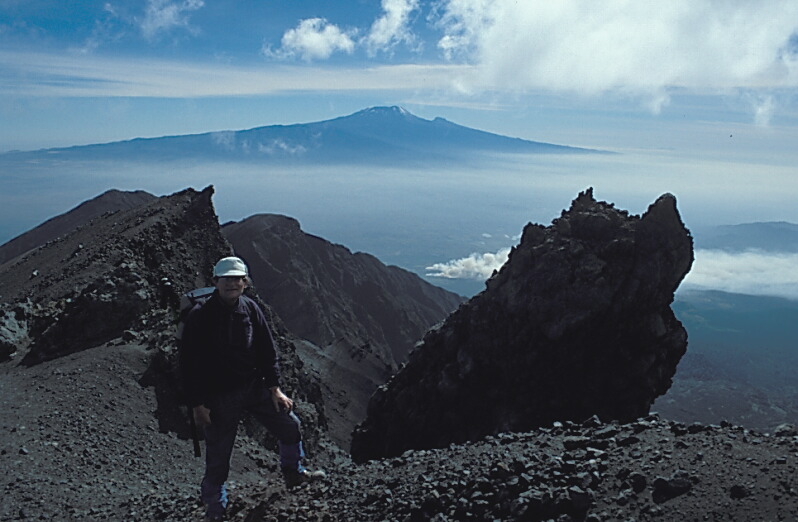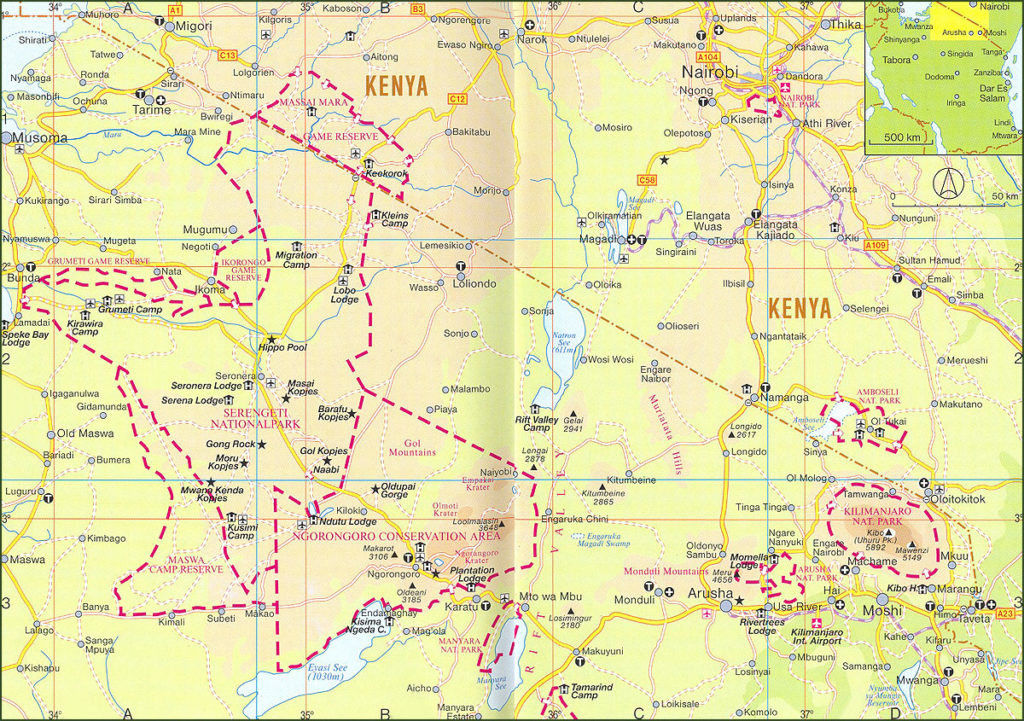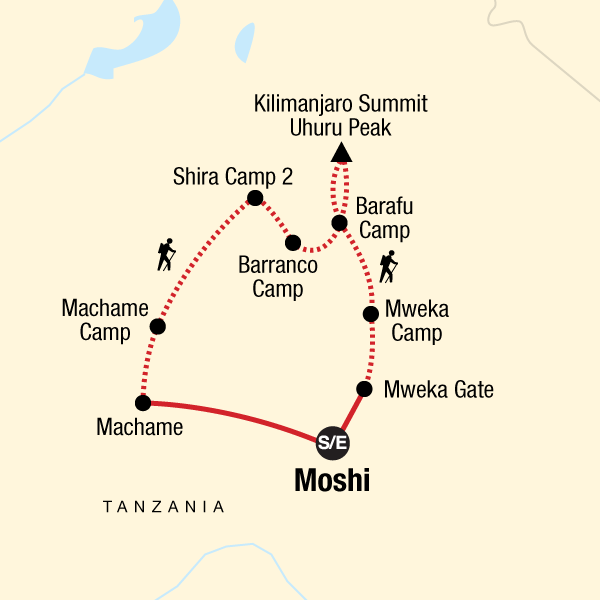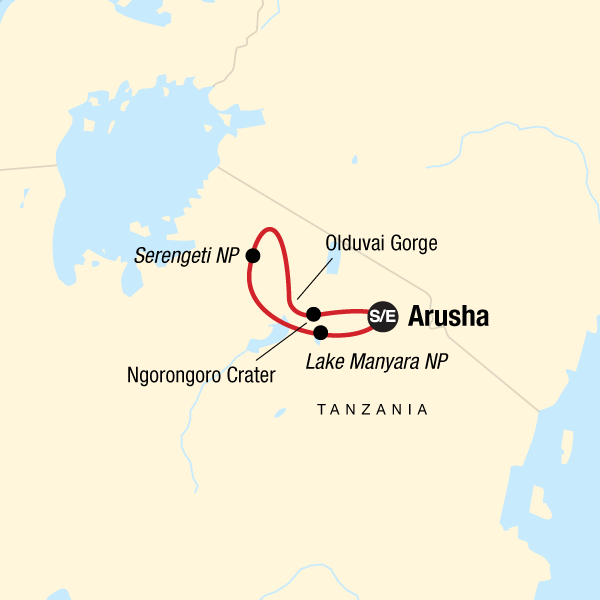
Adrian and Peter Wood climb Mount Meru and Kilimanjaro Machame route followed by a safari in the Serengeti and Ngorongoro parks, 17th.February to 10th.March 2003.
The tour was organised by Zara Tours, Moshi.
Kilimanjaro is one of the world’s highest volcanoes, and it’s the highest free-standing mountain on earth at 5,895m, rising from cultivated farmland on the lower levels, through lush rainforest to alpine meadows, and finally across a lunar landscape to the twin summits of Kibo and Mawenzi. Kilimanjaro’s third volcanic cone, Shira, is on the mountain’s western side. The lower rainforest is home to many animals, including buffaloes, elephants, monkeys, and leopards which are occasionally seen in the saddle area between Kibo and Mawenzi. A hike up Kili lures around 25,000 trekkers each year, in part because it’s possible to walk to the summit without ropes or technical climbing experience. Non-technical, however, does not mean easy. Because of the altitude the climb is a serious undertaking, requiring the right preparation.
Before approaching Kilimanjaro we started our acclimatization by ascending the nearby Mount Meru. This is the third highest peak in Africa and the second highest mountain in Tanzania at 4,568m. It is located in Arusha National Park, which gives trekkers the chance to spot some of the wildlife that inhabits the area. Because it is an older volcano than Kilimanjaro much of the crater has collapsed leaving a fine ridge for the ascent.
Most climbers of Kilimanjaro take the Marangu route staying at a series of huts, but we preferred the more scenic Machame route, which also has the advantage of allowing a longer period for acclimatization. We camped along the route with support from local guides and porters. Known as the “Whiskey Route” because of the tougher challenge, this path leads through magnificent forests before traversing a ridge leading through moorland to the Shira Plateau (3,840m). The route goes high to the Lava Tower (4,630m) on day 3 and then brings one down for a stay at the Barranco camp (3,960m). Early the next day the demanding Barranco Wall must be climbed. This is followed by great scenery beneath the glaciated precipices of the southern ice fields before summiting from the high Barafu Camp (4,640m) starting before midnight for a long day. En route to Uhuru Peak (5,895m), the highest point, one emerges onto high-alpine deserts with impressive views of ice fields and the crater rim of Mt Kilimanjaro. From the summit it feels as if the whole of Africa is laid out before you. The long descent is broken by a rest at the Barafu camp and an overnight stay at the Mweka camp (3,090m) before the final stage through jungle to the park gate at 1,650m.
After some relaxation at our hotel in Moshi we drove with a new guide to a lodge located at the edge of Lake Manyara National Park and set out the next day on our first safari drive to discover East Africa’s legendary wildlife. In the so called ‘green season’ the lake abounds with water birds, the most numerous being flamingos and pelicans. The park is also renowned for its tree-climbing lions. We then continued to the Serengeti and Ngorongoro reserves for our main safari experiences. On the day of our final return drive to Moshi we had the only rainfall of the holiday.
On the vast plains of the Serengeti, nature’s mystery, power and beauty surround you as they do in few other places. Here one of earth’s most impressive natural cycles has played itself out for aeons as hundreds of thousands of hoofed animals, move constantly in search of fresh grasslands. The most famous, and numerous, are the wildebeest (of which there are some 1.5 million) and their annual migration is Serengeti’s biggest attraction. In February more than 8000 wildebeest calves are born per day, although about 40% of these die before reaching four months old. The 14,763-sq-km national park is also renowned for its predators, especially lions. Hunting alongside them are cheetahs, leopards, hyenas, jackals and others. These prey on the wildebeest, zebras, giraffes, buffaloes, Thomson’s and Grant’s gazelles, topis, elands, hartebeests, impalas and many more. With luck one can spot all of the Big Five (lion, elephant, rhino, leopard and buffalo), although the rhinos are very rarely seen.
At 19km wide and with a surface of 264 sq km, Ngorongoro is one of the largest unbroken calderas in the world that is not flooded by a lake. Its steep walls rise 400m to 610m and provide the setting for an incredible natural drama, as prey and predators graze and stalk their way around the open grasslands, swamps and acacia woodland on the crater floor. There are hippos around the Ngoitoktok Springs picnic site, and Lake Magadi attracts flocks of flamingos to its shallows in the rainy season. Lereal Forest is good for elephants, of which there are 200 to 300 bulls in the crater. The side walls are too steep for groups of females with calves to enter. Predators include around 600 spotted hyenas, 55 lions (at last count), and both golden and black-backed jackals. These predators are sustained by large numbers of resident herbivores, with wildebeest, zebras, buffaloes and Grant’s gazelles being the most common. Around 20% of the wildebeest and zebras migrate annually between the crater and the Serengeti. Another major attraction is the chance to see the critically endangered black rhino, of which around 30 inhabit the crater floor.



